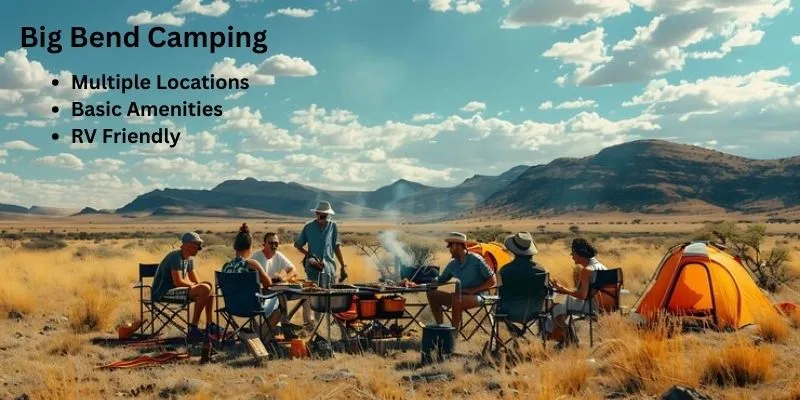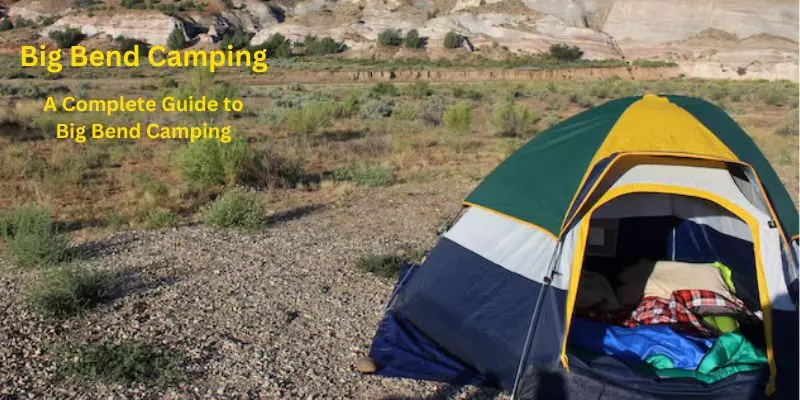Top 10 Hidden Gems: A Complete Guide to Big Bend Camping
Updated: 17 Aug 2024
244
Big Bend National Park is a hidden gem in the middle of Texas. It’s a place full of surprises waiting to be discovered. With its rugged landscape, diverse wildlife, and breathtaking views, this vast park offers an unforgettable camping experience like no other. Big Bend is huge and really pretty, but lots of people like to go there too. This means that the best camping spots can be crowded.
If you’re looking for a more secluded camping experience under the vast Texas sky, this guide is for you! We’ll explore the top 10 hidden gem campsites in Big Bend, offering scenery, peace and quiet, and all the information you need for a fantastic camping adventure. In this comprehensive guide, we will give the essentials of camping in Big Bend, including must-see hidden places, tips for a successful trip, and recommendations for exploring beyond the campsite.
Overview of Big Bend National Park
- Situated along the Texas-Mexico border, Big Bend spans over 800,000 acres of diverse terrain.
- Established in 1944, the park is named after the bend in the Rio Grande River that forms its southern boundary.
- Camping in Big Bend allows visitors to immerse themselves in the park’s natural beauty and experience its unique ecosystems up close.

Why Choose Big Bend Camping?
1. Multiple Locations
You can choose to camp in three different places inside the park: Chisos Basin, Cottonwood, and Rio Grande Village. Each place is special and different.
2. Basic Amenities
These campgrounds provide restrooms, drinking water, and picnic tables. Some even have designated fire rings for campfires.
3. RV Friendly
Some campsites can accommodate even larger RVs, making Big Bend accessible for all types of campers.
4. Rio Grande Village RV Park
If you have an RV, this campground is super easy. They have spots with water, electricity, and a place to empty your RV’s bathroom.
5. Primitive Sites
Scattered throughout the park, designated backcountry campsites offer a secluded escape. Primitive camping might be adventure you are waiting.
6. Self-Sufficiency
Backcountry camping means packing everything you need – food, water, shelter, and waste disposal items.
7. Permit Required
Always obtain a permit before embarking on your backcountry adventure.
8. Vehicle Access
Some backcountry sites are accessible by backpacking, while others require a high-clearance vehicle for designated backcountry roads. You can enjoy car camping there with camper fellows. On the other hand, if you want to truck camping, then you must enjoy a truck bed camping setup.
9. Hiking Adventures
Explore a network of trails catering to all skill levels. Hike through dramatic canyons on Lost Mine Trail or conquer South Rim for panoramic vistas.
10. Scenic Drives
Take a leisurely cruise along the Ross Maxwell Scenic Drive and soak in the breathtaking desert scenery from the comfort of your car.
11. Water Activities
Feeling adventurous? Canoe or kayak on the Rio Grande River for a unique perspective of the park’s vastness.
12. Night with Stars
With minimal light pollution, Big Bend boasts some of the darkest skies in the lower 48 states. Prepare to be mesmerized by the Milky Way and countless twinkling stars.
Big Bend Dome Camping
Big Bend National Park has a special kind of camping called glamping. Instead of tents, you stay in fancy round houses called geodesic domes. You can’t stay in these domes inside the park, but there are places nearby that offer them.
Glamping is like camping but much more comfortable. It’s a good way to enjoy the beauty of Big Bend without roughing it too much.
Why Is It Necessary To Use A Big Bend Camping Map?
Planning your Big Bend camping trip involves choosing your campsite, and a good map is key for that. The Big Bend National Park website offers a variety of maps to help you decide. There are maps showing the locations of the three developed campgrounds
- Chisos Basin,
- Cottonwood,
- Rio Grande Village within the park.
These maps also detail the campground loops and amenities. For a more adventurous spirit, the park website also provides maps specifically for backcountry camping.
Big Bend National Park Camping Cabins
| Cabin Type | Location | Amenities | Capacity | Reservation Required |
|---|---|---|---|---|
| Chisos Basin | Chisos Mountains | Beds, electricity, heating, restroom | 2-4 | Yes |
| Rio Grande Village | Rio Grande Village | Beds, electricity, heating, restroom, kitchenette | 2-6 | Yes |
| Castolon | Castolon Historic District | Beds, electricity, heating, restroom | 2-4 | Yes |
| Panther Junction | Panther Junction | Beds, electricity, heating, restroom | 2-4 | Yes |
Must-See Spots of Big Bend for Campers
While every corner of Big Bend offers something special, certain hidden gems stand out for campers seeking unforgettable experiences.
Santa Elena Canyon
- The best time to visit
- Hiking trails and activities
- Camping nearby
Lost Mine Trail
- Difficulty level
- Wildlife spotting opportunities
- Camping recommendations: Consider camping at the Chisos Basin Campground for convenient access to the trailhead.
Chisos Basin
- Scenic views: Marvel at panoramic vistas of the Chisos Mountains and surrounding desert landscape.
- Exploration options: Hike the various trails, go birdwatching, or simply relax and soak in the natural beauty.
- Camping facilities: Stay at the Chisos Basin Campground for stunning views and proximity to hiking trails.
Who is Big Bend Dome Glamping For?
Big Bend National Park offers a unique twist on the traditional camping experience – glamping in a dome Several private companies operate glamping dome experiences near Big Bend National Park.
1. Couples Seeking Romance
A romantic night under the stars, enjoying the desert views from your luxurious dome. Perfect for a romantic getaway.
2. First-Time Campers
Afraid of roughing it in a tent? Dome glamping offers a comfortable introduction to the wonders of Big Bend National Park.
3. Nighttime Nature Lovers
With minimal light pollution, Big Bend boasts some of the darkest skies in the lower 48 states. A dome glamping experience allows you to enjoy this incredible night sky in comfort.

Navigating Your Big Bend National Park Camping Map Adventure
Planning your Big Bend camping trip involves choosing your campsite, and a good map is essential for navigating the park and finding your perfect spot. Here’s what you need to know:
1. Official Park Maps
The National Park Service offers free maps at the park entrance. These maps provide a general overview of the park, including
- Designated campgrounds,
- Backcountry zones,
- Major roads.
2. Detailed Campground Maps
You can find more information about this topic online or by visiting the visitor center. Look for separate, detailed maps for each developed campground
- Chisos Basin,
- Cottonwood,
- Rio Grande Village
3. Backcountry Camping
Venturing into the backcountry requires
- Additional planning.
- Backcountry zone maps,
- Available online
- At the visitor center,
- detail designated backcountry campsites scattered throughout the park.
These maps also indicate which sites are accessible by foot and which require a high-clearance vehicle for designated backcountry roads.
Tips for a Successful Camping Trip for Big Bend Camping
| Tips |
|---|
|
Traditional Camping vs. Big Bend Camping
| Be aware of peak seasoFeatures | Traditional Camping | Big Bend Camping |
|---|---|---|
| Location | Various locations worldwide | Big Bend National Park, Texas |
| Campsite Options | Campgrounds, state parks, private sites | Developed campgrounds, backcountry sites, dome shelters |
| Amenities | Varies by location, may include picnic tables, fire rings, restrooms | Picnic tables, fire rings, restrooms (developed campgrounds), limited amenities in backcountry sites |
| Scenery | Depends on location, typically forests, lakes, mountains | Desert landscapes, rugged mountains, Rio Grande river |
| Activities | Hiking, fishing, swimming, wildlife viewing | Hiking, birdwatching, stargazing, river rafting, wildlife viewing |
| Wildlife | Varies by location, may encounter bears, deer, raccoons | Desert wildlife such as javelinas, coyotes, snakes, birds |
| Weather | Varies by location and season | Hot and dry climate, occasional thunderstorms, temperature fluctuations |
| Safety Considerations | Bears, wildlife encounters, weather conditions | Extreme heat, flash floods, desert wildlife encounters |
You can discover the Best Campsites in Nice.
Is It Safe To Camp At BIG Bend National Park?
Big Bend National Park offers a stunning desert landscape for camping adventures. However, like any wilderness experience, it’s important to be aware of potential hazards. The park’s remote location means help may not be immediate, and the desert environment presents challenges like scorching summers, flash floods, and wild animals.
But fear not! With proper planning, including informing others of your plans, checking the weather forecast, and practicing safe food storage, Big Bend National Park can be a perfectly safe camping and unforgettable camping experience.
Conclusion
Big Bend National Park offers a wealth of hidden gems for campers to explore. From the amazing Santa Elena Canyon to the tough Lost Mine Trail and beautiful Chisos Basin, there are lots of exciting things to do in this special and beautiful place. By following our comprehensive guide, you can make the most of your camping experience in Big Bend and create memories to last a lifetime.
FAQs
When’s the best time to camp in Big Bend?
The best time to camp in Big Bend is spring (March to May) and fall (September to November) when temperatures are mild and weather is pleasant. Summer is very hot, and winter nights can be cold.
Developed campgrounds or backcountry camping?
Some campgrounds have nice things like bathrooms and water. But if you want to be alone in nature, you can camp in wild places. You need a special permit and to bring everything you need.
What essentials should I pack?
Plenty of water, sunscreen, hat, sturdy shoes, first-aid kit, headlamp, and appropriate clothing for the season.
How do I reserve a campsite?
Reservations are required for all campgrounds. Book campsites well in advance, especially during peak season, on http://www.recreation.gov/.
Are there any safety concerns when camping in Big Bend?
Be aware of the remote location, flash floods during monsoons, and wild animals. Store food properly and dispose of trash responsibly.
Please Write Your Comments